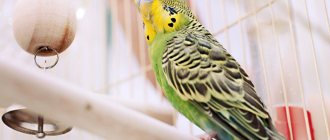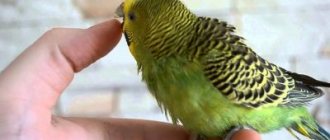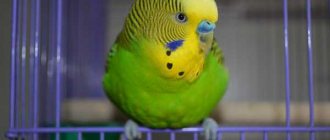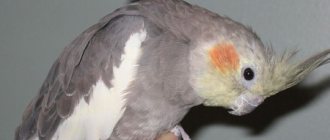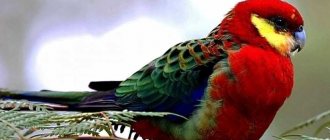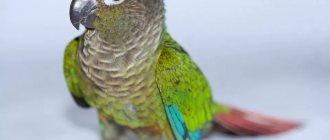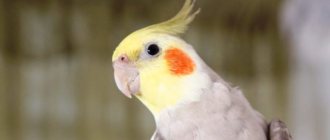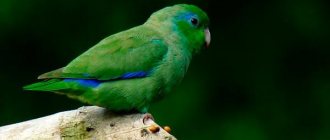At first glance, a parrot and a cat are the most unnatural combination possible. However, situations are different: one of the pets was brought by the “other half” of the owner of the house, a child picks up a cute kitten and asks to keep it, and so on. In such a case, the owners of square meters should think carefully about the question of what needs to be done and how they can organize life for two creatures that are completely not intended for this.
Is friendship possible between a cat and a parrot?
Cases of strong friendship between these species are rare, but not impossible. A cat and a parrot are able to play with each other, sleep together and even eat from the same bowl. After establishing a close relationship between the pets, the parrot will comb the cat's fur with its beak, and the cat will carefully lick its feathered friend. The bird can even ride around the house on the cat's back.
However, such a relationship is only possible if both pets have suitable characters. The four-legged animal should be calm and lazy, with absent or very weakly expressed hunting instincts. The bird should also be quite calm, not bully the cat and not take away its food. Pets should not have a tendency to show jealousy and aggression. Peaceful and friendly animals are more likely to make friends than willful and hyperactive ones.
War declared on a cat is a completely safe situation
Medium and large parrots can choose the path of dominance and fight back against predators.
Due to its strong beak and shrill voice, a parrot can greatly scare away a cat. In the future, she is unlikely to want to contact the bird.
If an adult parrot has a playful, cheerful character, then the task is much simpler. The bird can win over the cat and he will even agree to take part in such games. Funny battles will unfold in front of you every day, which will bring you a lot of laughter and ensure a good mood.
Risks of Shared Contents
Keeping such incompatible animals as a parrot and a cat together always entails certain risks:
- Injuries. The cat is a predator, and birds are its natural prey. If the parrot is free-ranging, the cat may attack it, kill it, or cause serious injury. The resulting injuries to internal organs are often incompatible with life. Additionally, even if the bird escapes with only minor scratches, its health may still be at risk. Cats' teeth and claws contain large amounts of bacteria that are deadly to birds (for example, Pasteurella multocida). Large parrots, defending themselves, in turn, can seriously injure a cat. Wounds from the beak and claws are deep, do not heal for a long time and can fester.
- Health problems due to stress. Even if the parrot is in a cage and the predator cannot reach it, the bird will experience constant stress from its presence nearby. As a result, she will begin to refuse food, pluck out her own feathers, become withdrawn and lethargic, or, conversely, will rush around the cage in panic. If the cat suddenly jumps on the cage or drops it, the bird may die from a heart attack. Constant nervous tension from the presence of a potential victim in the house can have a bad effect on the cat's health. He will become nervous, lose interest in games and communication with the owner, and chronic diseases may worsen.
- Mental problems. If predator and prey are forced to live in the same territory, they may develop mental disorders over time. A parrot from constant stress will become wild, timid and aggressive, will not communicate with the owner, and will not learn to speak. The cat will be fixated on getting the bird and may become aggressive towards the owner when he forbids her to do so. Some animals are afraid of parrots, especially large ones. Many cats cannot stand loud noises and, not being able to hide from the screams of a parrot in the limited space of an apartment, will experience constant stress.
Recommendations
Experienced and inquisitive owners of classic pets often decide to conduct all kinds of experiments.
As a result of much trial and error, such people have come up with a list of some recommendations that need to be followed when trying to answer the question of how to make friends between a cat and a bright, exotic parrot:
By following a list of fairly simple, classic tips, you can arrange a wonderful coexistence between two animals that, at first glance, are incapable of this.
Source
Cat's attitude towards different parrots
A cat's ability to get along with a bird depends on the size of the bird. Small parrots (for example, budgies, lovebirds) are most often perceived by cats as prey. Small parrots are active and fussy; their sudden movements and constant flickering before the eyes provoke the predator to hunt. Even if a cat lacks hunting instincts, an overly energetic and pestering parrot will irritate her. Due to their small size, the body of these birds is very fragile, therefore, simply brushing off a bird with its paw, a cat can cause serious injury to it.
Medium-sized parrots (cockatiels, lorikeets, necklaces, etc.) are easier to make friends with a cat. They are less suitable for the role of prey and are more often perceived by cats as equal partners in games and communication. Medium-sized parrots are not as fragile as small birds, have a stronger beak and are able to fend for themselves, but cannot cause serious injuries.
Large parrots (macaws, cockatoos, grays, amazons) also get along well with cats. Cats usually feel that such a large bird could be dangerous for them, so they try not to enter into conflict and do not attack first. However, if a large parrot is aggressive and cocky by nature, the owner may need to save the cat from its beak and claws. In addition, large species of parrots need constant communication with their owner and are painfully susceptible to loneliness. If such a bird is locked in a separate room to protect it from contact with a cat, it will become bored, attract human attention by screaming and plucking feathers, and may become aggressive or stop trusting its owner.
Video
If a budgerigar is grabbed by a cat or any other pet, such as a dog, then it is necessary to provide the necessary first aid to the parrot as quickly as possible, as well as organize proper treatment for the bird. Even the slightest damage caused by a cat is fatal to wavy birds.
The fact is that the normal flora in dogs and cats is the Pasteurella bacterium. For parrots, this bacterium is deadly. If it enters the blood of a bird, death occurs in 100% of cases. If it enters the gastrointestinal tract, death occurs in 70% of cases. It does not matter whether they were bitten or scratched by a cat or dog. The bacteria will get on the parrot's body in both cases. All it takes is a shallow scratch from a claw or a puncture in the skin from a bite. Death occurs from 2 to 10 days, depending on the parrot's immunity.
Therefore, help is needed immediately!
How to make friends between a cat and a parrot
The relationship that can develop between pets is influenced by the age of the animals and the time of their appearance in the house. The one who appears first on the territory will feel like the boss. Therefore, it is better to first purchase a parrot and bring the kitten into an apartment where an adult bird already lives. In this case, the parrot will be higher on the hierarchical ladder, and the kitten will not perceive it as prey.
On a note! An excellent option is to purchase a kitten and a chick at the same time. Young animals are easier to accustom to each other than adults who have developed character and habits.
After purchasing a new pet, you should observe its behavior and attitude towards the neighbor already living in the house. If the cat sits in ambush in front of the cage for a long time and tries to get to the bird, you should move the parrot to a room where the cat does not have access. If the cat is interested in the bird, but does not show obvious intentions to catch it, you can begin to carefully introduce the pets.
To accustom a kitten to a parrot, the animals must be given the opportunity to explore each other. To do this, the bird is released from the cage, and the kitten is picked up, holding its paws, and brought to the bird. The parrot will pick through the cat's fur with its beak, and the kitten will sniff the bird. Any attempts to touch the bird with your paw or bite should be stopped immediately.
If the kitten and parrot react calmly to each other, after some time they can be released for walks together. However, the owner must carefully monitor the animals in order to have time to intercept the predator if its hunting instincts awaken. Only adult animals that have lived together for a long time and in whose behavior the owner is confident can be left unattended.
Kitten feeding regimen
Young offspring feed more often than adult cats. Food should be served in small portions and be at room temperature
, or a little warmer. Gradually, the stomach of the small predator will increase, and the grown-up kitten will stop eating small portions. It is necessary to systematically reduce the number of feedings, increasing the daily food intake. The volume of the daily diet must be calculated relative to the weight of the cat. The approximate figures are as follows: 200g of food per 1kg of cat weight.
Number of small pet meals:
- 2 months – 6 feedings.
- 3 months – 5 feedings.
- 4 months – 4 feedings.
- 5 months – gradually accustoming the baby to a three-time feeding system: morning, afternoon, evening.
You need to feed your cat 2 times a day: morning and evening. Due to cats' natural need for amino acids, a meat diet is best suited for them rather than a vegetable diet and a diet of cereals.
For an adult, the daily serving volume is calculated taking into account the energy value: 70 kcal per 1 kg of cat weight. The daily measure of food consumption is calculated relative to the size of the cat: 50g per 1kg of animal weight.
An adult cat, weighing about 5 kg, should consume about 200 g of quality protein daily and about 50 g of plant and carbohydrate products.
If you are the owner of a purebred male cat, then his diet should include a large amount of vitamin E, which improves reproductive function. A good industrial feed can solve such a problem; you just need to choose the right one. You can feed your cat dry food 2 times a day, strictly adhering to the recommended dosage and without increasing it. If your furry animal is fed a homemade diet, then there are a number of restrictions on its stomach.
The cat should not be fed the following foods:
- Too fatty meat. Pork is absolutely unsuitable for feeding cats; it causes pancreatitis and kidney failure.
- A variety of smoked meats and pickles.
- Spicy, sweet and fried foods.
- Liver is not recommended. In its raw state it provokes flatulence, in boiled it causes constipation.
- Coffee and tea strain the cat's nervous and cardiac systems.
- Consumption of fish is not advisable, but is allowed as an exception once a week, boiled. Fish contributes to the development of urolithiasis.
- Potatoes are a completely useless product for a domestic carnivore, and the starch is not digested by the cat's stomach.
- Legumes cause bloating and intestinal problems.
- Vegetables are not a good food for cats. Almost all of them are harmful or useless for the cat's body. Your pet can only be fed carrots, zucchini, broccoli, cucumbers and celery. It is best to feed your cat vegetables chopped in a blender and mixed into a meat dish.
Every responsible breeder needs to regularly monitor the weight of the pet, weigh it regularly and compare the available results with generally accepted canons.
You can measure the amount of water your pet drinks per day and compare it with generally known norms. The cause for concern, in this case, is exceeding the norm of drinking water by 2 times.
How to stop a cat from hunting a parrot
If a cat and a parrot are having difficulty getting along and the cat tries to hunt the parrot, the owner should make it clear that he does not approve of such behavior. You can splash water on the animal, stamp your foot or clap your hands, while saying in a stern voice “No!” It is best to punish a cat from a long distance, so that it associates unpleasant sensations with its actions, and not with the hands of a person. If the owner is near the cat at this moment, you can take it by the withers, shake it slightly, bring it to your face and reprimand it.
Of course, after these actions the cat will not lose interest in the parrot immediately, and training may take a long time. The owner must be patient and consistent - only in this case can peace be achieved between pets. You should not hit a cat or lock it in a separate room. So she will stop trusting the owner and begin to take revenge on the parrot.
Compatibility
From a school biology course, we know about the existence of a food chain, and representatives of the cat family are at a fairly high place in it. Moreover, among the main food of furry pets living in the wild, there are all kinds of beautiful feathered creatures - pigeons, crows, sparrows and swallows. Of course, an exotic, beautiful, bright and sociable parrot is quite a big surprise for its clawed fellow, but sooner or later the cat will come to its senses, realizing that in front of it is a familiar part of the diet, only in a different color.
The proximity of a classic cat and a bright, sociable parrot is a completely wrong situation that does not add any positive aspects to the lifestyle of both creatures.
The laws of nature have not been repealed, and although outwardly cute and fluffy, very domestic kittens are essentially hunters and predators.
At the same time, an exotic parrot, living in pleasant conditions of human care, inevitably suffers from a dulling of instincts associated with self-preservation. At the same time, the birds begin to show curiosity, which often turns into the legendary “parrot” impudence. Naturally, such behavior can end quite disastrously.
